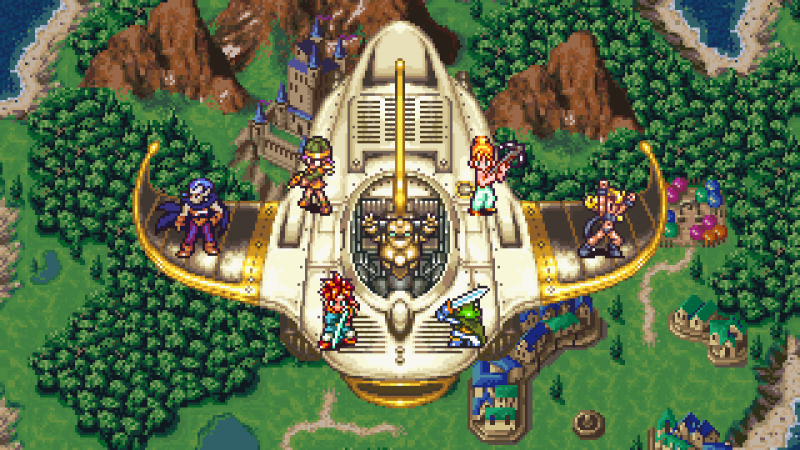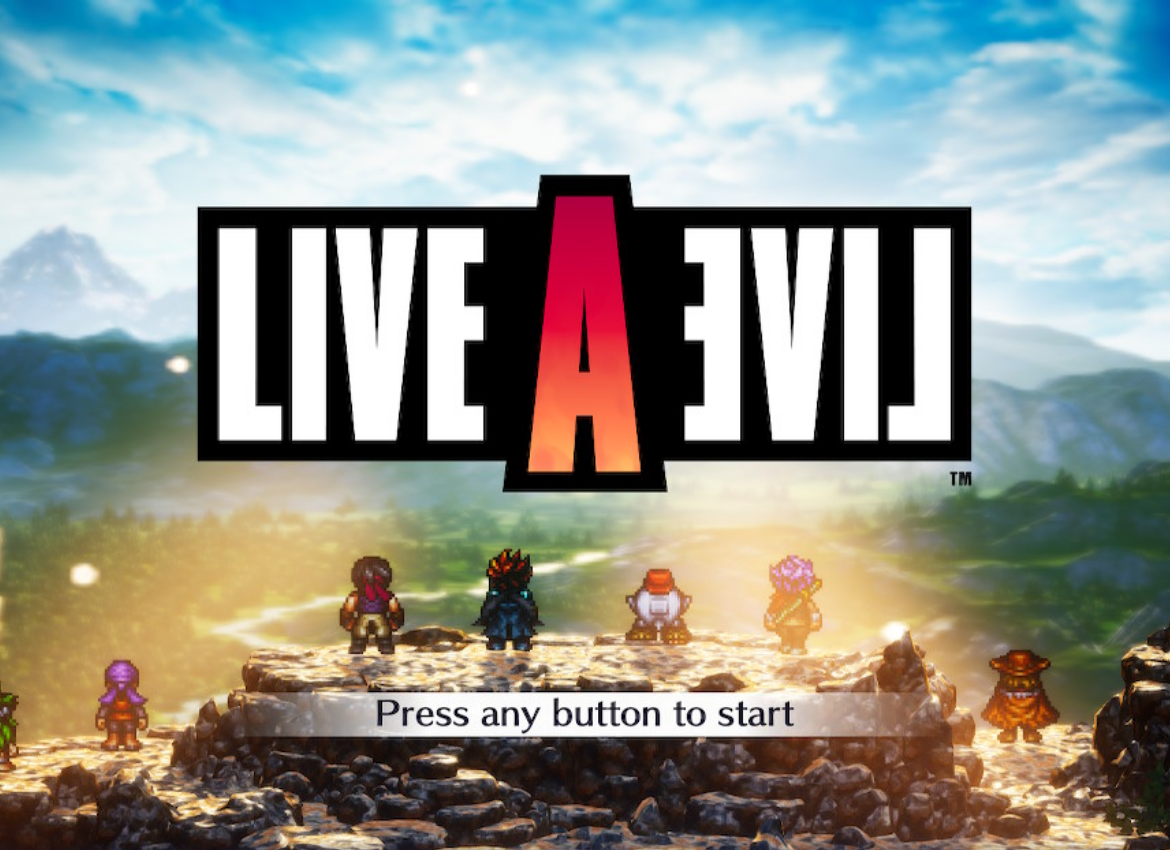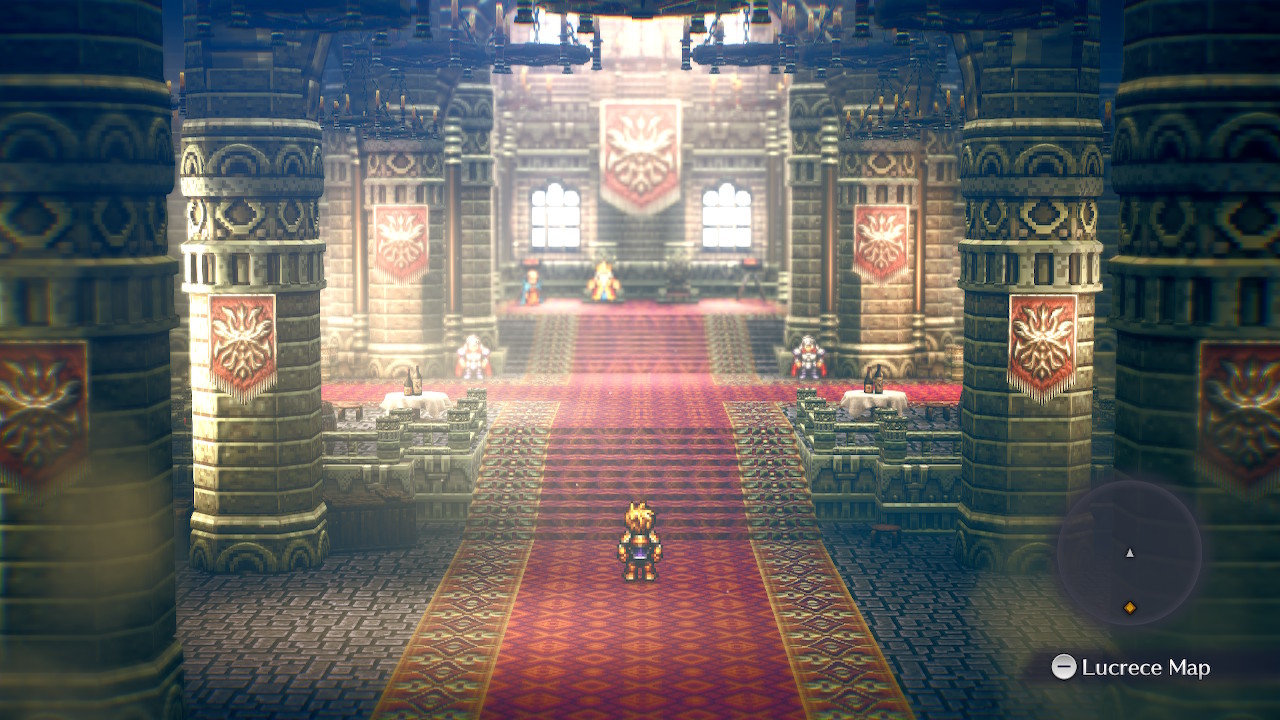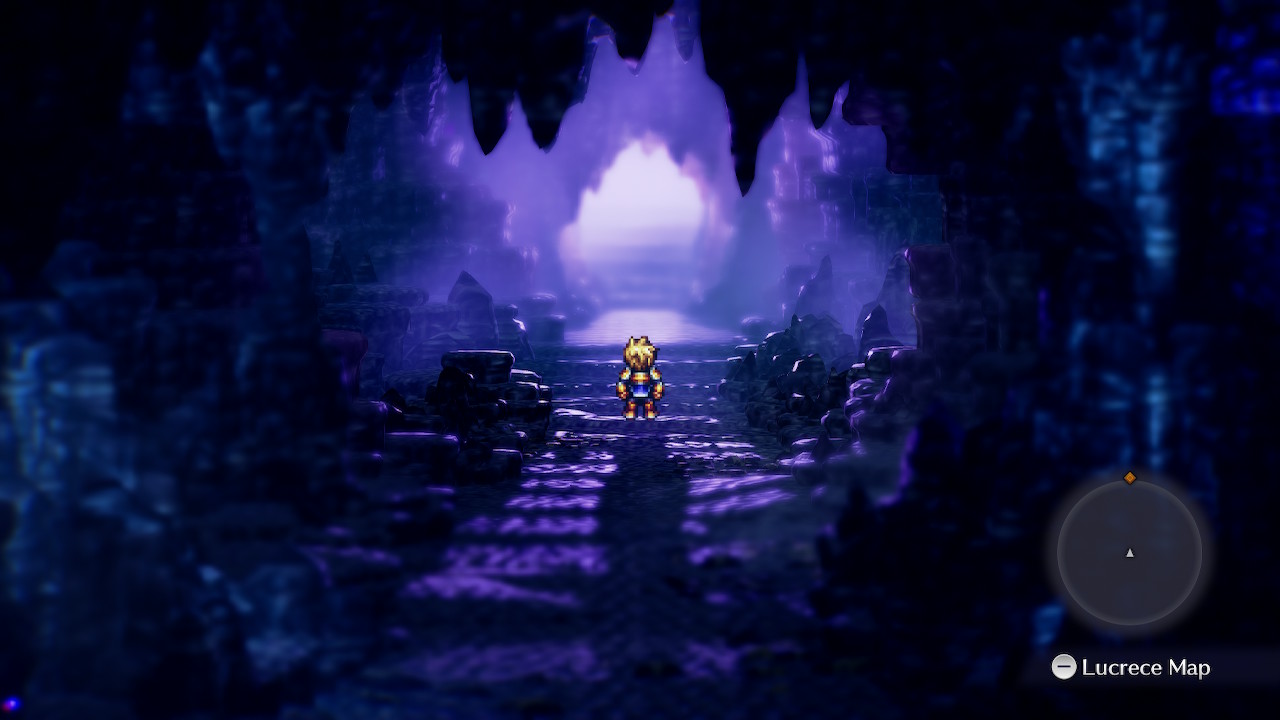Discover Square’s cult-classic SNES title in its Western debut in our LIVE A LIVE review.
If you grew up playing JRPGs (that’s Japanese Role-Playing Games for the uninitiated), chances are you have an immense fondness for the 16-bit era. Beginning in 1987 and spanning into the mid-90’s, dominated by the Super Nintendo and SEGA’s Mega Drive/Genesis, many consider this decade to be the golden years for RPGs. And it’s easy to see why – influential titles like Chrono Trigger, Final Fantasy IV & VI, Phantasy Star, and EarthBound just to name a few, all set the standard for any games that would follow in their legacy.

Chrono Trigger (1995) is the quintessential 16-bit JRPG, still considered by many as the finest ever made.
Though with the J in JRPG standing for “Japanese”, it was inevitable that some superb software would never make its way to Western shores. This was sadly the case with Square’s Live A Live (ライブ・ア・ライブ), released only in Japan exclusively for the Super Famicom in 1994. This would be the directorial debut of Takashi Tokita (director of Chrono Trigger, Parasite Eve), whose influence on the genre cannot be understated. Rather than limiting themselves to a single story, the team instead sought to combine the plights of seven heroic protagonists from across time and space through a series of creative short stories. Thus Live A Live was born – a cult classic that would elude a Western audience for close to 3 decades.
Thankfully, the wait is over. With the retro revival of the 16-bit era thanks to Square Enix‘s very own HD-2D series, Live A Live lives another life on Nintendo Switch! So is this lively cult classic worthy of the wait? Read ahead and explore the seven stories that await you in…

Story
Where the story of most traditional JRPGs is presented through a single lens, often the eyes of a lone heroic sword-wielding evil-slaying protagonist, Live A Live decides instead to take this role and split it into seven parts. Spread across time, space, and culture, the story of Live A Live can be experienced in an order by choosing any of the following settings:
Prehistory – set before the discovery of speech, this amusing short story focuses on a race of cave-dwellers, and centres on a young boy who falls helplessly in love with a beautiful escaped captive. Alongside his sentient gorilla friend, Goro, the pair venture forth on a journey of love, physical comedy, and plentiful slapstick humour.

Imperial China – high in the mountains, in solitude honing his art, lives the masterful Shifu, an elderly man skilled in legendary martial arts. Though the Shifu knows his time left on this earth is short. And so, with heightened resolve, Shifu descends from his mountainous abode to train a rightful heir to pass on his martial skills. Will he choose the deft and wily feminine thief, the gluttonous and earth-shatteringly large lad, or a simple young man who’s passion for justice outweighs his physical prowess?

Twilight of Edo Japan – tasked with the infiltration of a colossal fortress and the safe retrieval of a hostage, a skilled Shinobi slips into the shadows even in plain sight. Though even the most proficient ninja must be wary of the tricky traps and powerful foes that lay in wait ahead. Explore a sprawling castle and ascend to the throne room in this tale of feudal warfare, deception, and the art of the Ninja.

The Wild West – a lone stranger, a gun-slinger on the lam, and the fastest trigger finger in the West. Well that’d be none other than The Sundown Kid. Though upon wandering into a bar in the humble town of Success, the kid encounters an old foe and learns of one town’s plight to stand up against a ravenous group of bandits. How will you aid the town, or rather, how will the town of Success lead to your success in battle?

Present Day – Why do you fight? Is it for glory or purpose? For strength, or for your friends? Masaru Takahara, a young man with great ambitions, fights to be number one. Though to become the world’s strongest, he must first defeat the world’s strongest. Conquer challengers from across the globe in this combat-focused scenario drawing inspiration from the likes of Street Fighter.

The Near Future – Akira, a rebellious youth living in an orphanage, holds within him a secret beyond comprehension: the ability to read minds. It’s through this latent power that Akira pieces together the mysteries behind a sinister biker group terrorising his town and kidnapping its citizens. The key to their defeat? The STEEL TITAN – a colossal weaponised robot that lies dormant beneath the city. But who has the power to awaken it and save the city?

The Distant Future – adrift in space, cargo ship Corgito Ergo Sum and its crew transport a highly-dangerous biological life-form, tasked with its safe transit to Planet Earth. With the crew in cryo sleep, they are soon awoken by a spherical assistance robot designed by the ship’s engineer, Kato. But something aboard the Corgito Ergo Sum is not as it seems – the crew begin acting odd, the Captain seems suspiciously distant, and even the ship’s AI poses questionable reliability. Will the crew make it safely to Earth?

Gameplay
But enough about the story – this isn’t a visual novel, it’s an RPG! Live A Live draws upon many familiar aspects of traditional JRPGs in its gameplay – seamlessly combining story with exploration and combat to meld an engaging ~25 hour journey across multiple varied settings. Some of the scenarios play out according to the standard format of the genre, with players exploring various environments, interacting with characters, fending off random encounters, and unravelling a story. Though this is not always the case for each protagonist in Live A Live:

Prehistory is completely lacking in any form of text or dialogue, instead relying on physical actions to tell a story. The player must utilise the protagonist’s sense of smell to locate enemies, crafting items (e.g., stick + stone = spear) to enhance their character rather than conveniently finding gear in an unguarded chest.

Imperial China relies heavily on training, with the player given the choice to train three talented pupils. This occurs through sparring matches, whereby the pupils may learn moves from the Shifu, cleverly utilising the game’s combat in this unique mechanic.

Twilight of Edo Japan is all about stealth and exploration, avoiding combat where possible. As a Shinobi, the main character has the ability to hide in plain sight by pressing Y. Players may navigate the labyrinthine castle in various ways – either with katana drawn, or by carefully avoiding combat altogether.

The Wild West is a one-shot (get it?) scenario about saving a town, and is less about combat and more about clever time-management. By setting traps around the town of Success, the player is given an advantage during the final gun-slinging showdown with The Crazy Bunch.

Present Day is a fighting game. Literally. Entirely focused on combat, players must compete across several bouts of combat to learn moves from their opponents and progress through the ranks. This is the shortest of all scenarios, featuring very little dialogue, and is rather a crash course for learning the game’s combat.

Near Future is very much a traditional RPG, with the player exploring varied locales, fighting through encounters to level up their character, and uncovering the dastardly plot of the biker gang. This is all done with a psychic twist, as the protagonist can press Y to read the minds of NPCs, revealing their inner thoughts and unlocking new possibilities to the gameplay.

Distant Future is heavily focused on story, as if playing through a science fiction film. Incredibly tense and atmospheric, Cube the robot must traverse the hulking space craft, interact with its crew, and avoid any threats in order to progress this gripping sci-fi story.
Each scenario varies not in terms of setting and characters, but also features unique gameplay mechanics.
The one element that each scenario shares is combat, which is a key aspect of Live A Live that players will need to master in order to progress through the game. Where most RPGs of the era are turn-based, Live A Live instead opts for a tactical combat style, with all battles being held on a 7 x 7 grid. Each character is assigned with an action bar, which fills based on their speed stat, and once full allows the character to take an action such as a movement, an attack, or a powerful ability. Certain abilities will hit only the adjacent tiles, while others will be able to launch attacks at distant tiles or across and entire area for a larger effect.

It’s like chess but not boring.
While the combat certainly does take some getting used to, the game does incredibly well in teaching the player how to fully utilise it through each of the scenarios. Some feature little-to-no combat, while others are almost entirely focused on it, meaning that by the game’s finale, any player should be well-versed in battle with the means to take on the game’s toughest foes. Be sure to practice, because you’ll need a thorough understanding for the last chapter!
Visuals
Those who haven’t played either Octopath Traveler or Triangle Strategy may yet be familiar with the concept of HD-2D. Coined by Square Enix in 2017, this graphical style blends traditional 2D sprites (particularly those of 16-bit games) with high-definition lighting, particle effects, and polished polygonal graphics. The end result is a game that looks as if it effortlessly spans time periods, revitalising the classic aesthetic of the ’90s while injecting a level of visual polish that was impossible at the time.

With varied cultural backgrounds, each protagonist brings a fresh visual style.
Live A Live is the latest in the HD-2D series, and is the most visually varied to date, featuring contrasting environments, cultural backdrops, and time periods that are represented through its visuals. These backgrounds are visually stunning regardless of the scenario, and when combined with Square Enix’s flawless spritework, makes every segment of the game a pleasure for the eyes. Throughout my time with Live A Live, I took more screenshots and captures than I care to admit, and will share some of my favourites just to showcase how breath-taking this game can be:
Audio
Two words: Yoko Shimomura. Need I say more? This legendary composer originally created the music for Live A Live back in 1994, masterfully crafting a suite of songs to define each character and setting. Shimomura would then go on to compose for games like Super Mario RPG, Kingdom Hearts, the Mario & Luigi series, and even my personal favourite, Xenoblade Chronicles. So you know when Yoko Shimomura is the composer, your eardrums are in for a good time. This is elevated in the Switch remake with a fully orchestrated soundtrack, taking the classic chiptunes and revitalising them aurally much like HD-2D has done for the game’s visuals. Please enjoy a small selection of my favourite tracks from the game:
The game’s epic main theme, which greets players on the title screen.
Megalomania (no, not Megalovania) is often used to accompany boss fights.
“To Arms!” from Edo Japan is a perfect example of the game’s culturally-inspired tracks.
Credit must also be given to all the voice actors who contributed toward Live A Live, with a huge variety of performances across each scenario. As with Square Enix’s previous HD-2D games, players are given the option to choose either an English or Japanese audio dub, and having swapped back and forth between these during my playthrough, you really can’t go wrong either way. The game feels most authentic with the Japanese dub in certain scenarios such as Edo Japan, but the English dub for scenes like Wild West and Present Day just feels perfect.
What Else?
In addition to the seven scenarios that the player can choose from, there is a significant amount of post-game content which I won’t directly discuss due to the possibility of spoilers. This can only be accessed once completing every single scenario and is well worth playing to completion, as doing so will allow players to unlock the game’s true ending.

Be sure to keep playing once you’ve finished the seven scenarios!
Aside from some minor optional content like a combat minigame available in the Distant Future scenario, there’s not an awful lot else on offer in Live A Live outside of its ~25 hour main story. Notable mention goes to the inclusion of a Jukebox, which is unlocked after completion of each chapter, adding new songs to enjoy as the player progresses.
LIVE A LIVE Review Conclusion
Cult classic is a term that’s thrown around a lot when referring to retro games, but Live A Live is exactly that. This retro JRPG that once remained elusive to Western audiences has been polished, modernised, and perfected for Nintendo Switch, once again showcasing the power of HD-2D. With a compelling cast of characters, superb voicework and soundtrack, and a visual style that timelessly rejuvenates classic sprite art, Live A Live for Nintendo Switch proves that classic JRPGs are a-live and well. All JRPG fans must experience Live A Live.
So, why should you play it?
- Are you a fan of classic JRPGs? This is necessary playing.
- Enjoyed the varied storytelling style of Octopath Traveler.
- Flawless visual style combining retro and modern elements.
- Soundtrack from Yoko Shimomura among some of her best.
- Stellar localisation, with amusing and witty dialogue and voice acting.
But why shouldn’t you play it?
- Don’t own a Nintendo Switch? Too bad.
- Prefer games with a single main protagonist.
Get an unbeatable deal on a copy of LIVE A LIVE here!
A review code was kindly provided by Nintendo Australia for the purpose of this review. If you enjoyed this review, please check out more of our articles and reviews here or follow us on Facebook, Instagram, and Twitter.
In order to keep bringing you quality content at Qualbert.com, we may receive a small percentage of revenue from each sale.


















